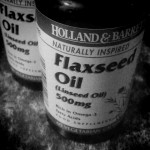 Dietary intake of the omega 3 fatty acid alpha linolenic acid (ALA, C18:3 (n-3)) has been shown to be inversely associated with blood pressure in humans. For example, in one study1, the association between ALA and blood pressure was investigated through use of adipose tissue biopsies as a marker of dietary intake. This was done because essential fatty acid ratios in adipose tissue are generally considered to accurately reflect their dietary intake. The results of the study showed that the adipose tissue concentration of ALA was inversely associated with blood pressure, whereas the omega 6 essential fatty acid linoleic acid (LA, C18:2 (n-6)) was not. Further, stepwise analysis of the data showed that every 1 % increase in dietary ALA was associated with a 5 mm Hg decrease in systolic, diastolic and mean arterial blood. Analysis of the adipose tissue showed that LA was nearly 8 times as numerous in adipose tissue compared to ALA, with LA acid comprising 16 % of the total fatty acids and ALA 2% of the total fatty acids in adipose tissue.
Dietary intake of the omega 3 fatty acid alpha linolenic acid (ALA, C18:3 (n-3)) has been shown to be inversely associated with blood pressure in humans. For example, in one study1, the association between ALA and blood pressure was investigated through use of adipose tissue biopsies as a marker of dietary intake. This was done because essential fatty acid ratios in adipose tissue are generally considered to accurately reflect their dietary intake. The results of the study showed that the adipose tissue concentration of ALA was inversely associated with blood pressure, whereas the omega 6 essential fatty acid linoleic acid (LA, C18:2 (n-6)) was not. Further, stepwise analysis of the data showed that every 1 % increase in dietary ALA was associated with a 5 mm Hg decrease in systolic, diastolic and mean arterial blood. Analysis of the adipose tissue showed that LA was nearly 8 times as numerous in adipose tissue compared to ALA, with LA acid comprising 16 % of the total fatty acids and ALA 2% of the total fatty acids in adipose tissue.
If adipose tissue concentrations accurately represent dietary intakes of fatty acids, these results suggest that the dietary ratio of LA to ALA in these subjects was about 8 to 1. However, the current recommendations based on the nutritional literature suggest that this essential fatty acid ratio should be around 3 to 1. Generally the Western diet is too high in LA and too low in ALA, and this causes an imbalance in the essential fatty acid ratio. When the essential fatty acid ratio is imbalanced like this, deleterious changes to the metabolising pathways can causes metabolic dysfunction that can lead to inflammation and disease. Therefore although the ALA intake is inversely associated with blood pressure, this is actually an artifact of a rebalanced essential fatty acid ratio. By increasing the ALA content of the diet, an individual restores the correct dietary essential fatty acid ratio to around 3 to 1. This then has beneficial effects on essential fatty acid pathway flux, a side effect of which is the restoration of correct blood pressure control.
RdB
